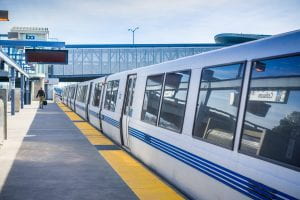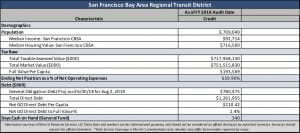
November 19, 2017 Oakland/CA/USA – BART train ready to depart from Coliseum BART stop, east San Francisco bay area (photo from depositphotos.com)
Featured Bond – Week of July 29, 2019: San Francisco Bay Area Rapid Transit District – $674 Million in GO Bonds (Green Bonds)
By Ashton Hicks
Overview
The San Francisco Bay Area Rapid Transit (BART) District is issuing $674 million total in General Obligation Green bonds through negotiated sale. Most of the proceeds are being used to finance improvements to BART facilities. A portion of the bonds will also be potential refunding of a portion of outstanding Measure AA 2013 Series C Bonds. The Climate Bonds Initiative has labeled the 2019 Bonds as Climate Bond Certified. The bonds conform with the Climate Bond Standards Board’s Low Carbon Transport standard.
The bonds are rated Aaa by Moody’s and AAA by S&P.
More About the Bonds & BART
The bonds are broken down into the following:
- $309 million Measure RR (Election of 2016) 2019 Series B-1 (Tax-Exempt)
- $50 million Measure RR (Election of 2016) 2019 Series B-2 (Federally Taxable)
- $201 million Measure AA (Election of 2004) 2019 Series F-1 (Tax-Exempt)
- $38 million Measure AA (Election of 2004) 2019 Series F-2 (Federally Taxable)
- $74 million Measure AA (election of 2004) 2019 Refunding Series G (Federally Taxable)
Measure AA bonds will fund a portion of the Earthquake Safety Program. This includes upgrading various portions of the original system to ensure safety of the public and employees of BART, and preparation of rapid return to operations after a major earthquake. The Measure AA bonds will also retrofit the Transbay Tube, upgrade aerial structures, stations, and parking structures, and strengthen tunnels, bridges, systems, and overhead tracks.
Measure RR bonds will be used to replace track, rebuild and renew power infrastructure, repair tunnel structure, renew critical safety infrastructure, renew stations, replace train control and other major infrastructure to increase peak period capacity, expand opportunities to safely access stations, and relieve crowding.
The BART District was created in 1957 to provide regional rapid transit service in the San Francisco Bay area. The tax base includes Alameda, Contra Costa, and San Francisco Counties. In FY2018, ridership totaled over 20 million averaging 412,030 weekday exits. The system is comprised of 121 miles of dual mainline track, 48 stations, 49,000 parking spaces, and approximately 700 cars. Assessed value of the BART District has grown 50.5% over the past 10 years. The population of the District has grown over 10% to 3.7 million since 2010.
Security for the Bonds
The bonds are secured by ad valorem taxes upon all property subject to taxation by the District – the counties of Alameda, Contra Costa, and San Francisco. The taxation is without limitation as to rate or amount except as to certain personal property which is taxable at limited rates. The District determines the tax rate required to pay debt service. All three of the BART Counties have adopted the Teeter Plan by which each agrees to cover the tax delinquencies, but Alameda County does not apply its Teeter Plan to the collection of taxes for GO bonds.
These details and more on purposes, security, risks and other matters pertaining to these BART General Obligation Bonds can the found in the official statement, provided by MuniOS. After registering, if needed, visitors can link directly to the official statement as well as an investor’s roadshow by searching for San Francisco Bay Area Rapid Transit District.
Provided above is a quick snapshot of financial characteristics of the San Francisco Bay Area Rapid Transit District, courtesy of Merritt Research Services, LLC. (Merritt believes the data to be reliable but does not make any representations as to its accuracy or completeness).
In addition to the Merritt information related to the featured bond, more information can be found on our municipal bond calendar, city, state, and county pages.
These facts and numbers are for informational purposes, and should not be considered an official disclosure for potential investors. Investors should consult the official statement. None of the information provided should be construed as a recommendation by MuniNet Guide, MuniNet LLC, Merritt Research Services LLC, or any of their employees. Information and analysis is for informational purposes only.
Potential investors should rely only on the official documents and figures provided in the official statement (prospectus). Although the numbers presented in this summary are primarily derived from public documents, including issuer audits, issuer reports and other public sources such as federal reporting agencies , they are not intended to replace official information presented in connection with the bond sale. Medians may differ from official sales documents due to methodology or survey base variances.

